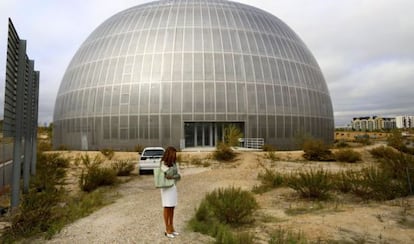The multi-million cost of promoting Madrid’s failed City of Justice
Regional government spent almost €6 million on exhibitions and advertising for project

The Madrid regional government spent almost €6 million to promote a failed project to bring the infrastructure of the capital’s legal system together on a single site, according to a 2009 report by the organizers of the project that EL PAÍS has had access to.
The report says that between 2007 and 2008, the head of the Popular Party (PP)-controlled regional government of Madrid at the time, Esperanza Aguirre, organized 72 events around the world to promote the City of Justice project, visiting Milan twice, Munich three times, as well as London, Singapore, New York, Cannes, Buenos Aires and other world cities.
Many of the buildings were designed by internationally renowned architects such as Norman Foster
Construction got underway in February 2007, but the following year Spain’s real estate bubble burst, sending the country into a protracted crisis and halting the sale of existing buildings in Madrid, the proceeds from which were due to fund the City of Justice.
The dome-shaped Madrid Forensic Anatomical Institute – the only one of the project’s 14 buildings to be erected – has never been used, and has repeatedly had to be cleared of rabbits. Experts say that putting it into use would cost at least €5 million.
Last week, opposition deputies quizzed a special commission set up to look into the €26-billion debt accumulated by the regional government, but were given no details. Socialist Party deputy Mercedes Gallizo noted that the video used to explain the scheme cost €900,000, pointing out that the average budget for a Spanish feature film is around €1.2 million.
In 2010 Francisco Granados, then-head of the regional government’s justice department and currently in prison awaiting trial for his alleged involvement in a corruption scandal, told the Madrid regional parliament that a total of €926,000 had been spent on what he called “strictly advertising,” adding that a further €5 million went on “exhibitions.”
At the time, current Madrid premier Cristina Cifuentes, who was then a PP spokeswoman, defended the spending: “A large portion of the costs related to inaugurations and other items have been covered by the private companies involved, as was specified in the conditions for bidding.”
In 2007, the year when the foundation stone was laid at an event costing €1.5 million, a five-week exhibition about the representation of justice in painting was staged in Madrid that included a scale model of the planned scheme. The exhibition featured works by Goya and other leading Spanish artists borrowed from private and public collections.
Just a megalomaniac project?
The investigation into Madrid’s City of Justice, led by regional Podemos representative Lorena Ruiz, is trying to determine whether simple megalomania was behind the mammoth project – as even former premier Esperanza Aguirre, its main sponsor, has admitted – or if there was something else.
Besides the numerous global presentations, the public corporation in charge of the site paid for a collection of useless reports, some of which cost up to €80,000.
Additionally, the majority of the employees at the non-functioning complex held senior-level positions with salaries of up to €106,000. And most of them got their jobs through an arbitrary selections process or because of kinship ties.
A year later, Madrid’s Royal Tapestry Factory staged another exhibition along similar lines, featuring pieces by Joaquín Sorolla, Julio Romero de Torres and Goya. It also included an educational program designed by New York’s Museum of Modern Art.
The 2009 report also mentions a number of events “with greater or lesser repercussion,” held to present each of the buildings due to be built in the City of Justice. Many of these buildings were designed by internationally renowned architects such as Norman Foster and Zaha Hadid, both of whom attended the presentations.
Eduardo Gutiérrez, the spokesman for anti-austerity party Podemos on the debt commission, unsuccessfully asked Enrique Ruiz, the deputy head of the regional justice department, for details of the 72 events.
Gonzalo Quiroga, the legal representative of the City of Justice Project between 2010 and 2011, told deputies that the construction companies that had been awarded contracts were “obliged by contract to spend 1.5 percent of their budget on advertising.”
Around €105 million was spent on the City of Justice by the regional government of Esperanza Aguirre. Most of it went on audits, legal fees and designs by architects such as Norman Foster, who was paid €10.6 million. More than €27 million was spent on paying construction companies for work that was never carried out, a further €6.4 million went to compensate suppliers, while €11.4 million was paid in rescinded contracts, along with interest payments and other costs. Of the total amount, just €17.3 million actually went towards building something.
An overburdened system
Also last week, two organizations representing Spain’s judges released a statement calling for action to address the capital’s legal system, which like the rest of Spain’s is under-resourced, run-down, and subject to lengthy delays: “The lack of investment in this public service has led to a justice system on the verge of collapse, with half of judicial bodies over-burdened.”
Tu suscripción se está usando en otro dispositivo
¿Quieres añadir otro usuario a tu suscripción?
Si continúas leyendo en este dispositivo, no se podrá leer en el otro.
FlechaTu suscripción se está usando en otro dispositivo y solo puedes acceder a EL PAÍS desde un dispositivo a la vez.
Si quieres compartir tu cuenta, cambia tu suscripción a la modalidad Premium, así podrás añadir otro usuario. Cada uno accederá con su propia cuenta de email, lo que os permitirá personalizar vuestra experiencia en EL PAÍS.
¿Tienes una suscripción de empresa? Accede aquí para contratar más cuentas.
En el caso de no saber quién está usando tu cuenta, te recomendamos cambiar tu contraseña aquí.
Si decides continuar compartiendo tu cuenta, este mensaje se mostrará en tu dispositivo y en el de la otra persona que está usando tu cuenta de forma indefinida, afectando a tu experiencia de lectura. Puedes consultar aquí los términos y condiciones de la suscripción digital.
Últimas noticias
Pinochet’s victims grapple with José Antonio Kast’s rise in Chile
Reinhard Genzel, Nobel laureate in physics: ‘One-minute videos will never give you the truth’
From digital curfews to blocking apps: How technology experts protect their children online
Why the price of coffee has skyrocketed: from Brazilian plantations to specialty coffee houses
Most viewed
- Pablo Escobar’s hippos: A serious environmental problem, 40 years on
- Why we lost the habit of sleeping in two segments and how that changed our sense of time
- Trump’s obsession with putting his name on everything is unprecedented in the United States
- Charles Dubouloz, mountaineering star, retires at 36 with a farewell tour inspired by Walter Bonatti
- The Florida Keys tourist paradise is besieged by immigration agents: ‘We’ve never seen anything like this’









































